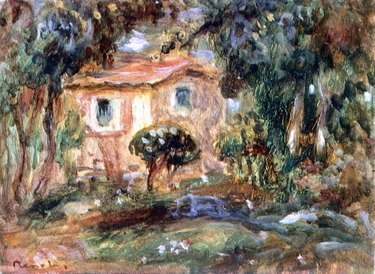
Having a painting authenticated is not the same concept as having a painting appraised. Painting authenticity is often required by art dealers if you want to sell your fine art. Paintings by well-known artists, including Renoir and Monet, for example, are often copies. Painting authenticity can be achieved by taking the painting to a reputable knowledgeable expert, specializing in painting authentication. Before traveling with your painting to gain an authentication, which may damage it, there are requirements the dealer or seller will have before authenticating it. Being aware of these requirements up-front can save time and money.
Step 1
Inspect your painting for damage. Most art dealers or sellers will not authenticate a painting that is too badly damaged, too faded, ripped or one that has obvious stains. If your painting has any of these issues, you could be rejected for receiving an authentication.
Video of the Day
Step 2
Call various art dealers and art sellers to choose the right one for you. Understand going in that they are not all the same. There will be a cost involved to have your painting authenticated. The cost will vary depending upon the expert, their knowledge and the level of research done with your painting. If you want a dealer specializing in animal and plant DNA residue, high resolution digital images and mathematical formulas, as well as in-depth research done with your painting to achieve a highly accurate painting authentication, expect to pay more to achieve this goal. If cost is an issue, and you are not as concerned about how in-depth the research is or how detailed the authentication is, a less costly situation may be the answer for you. However, choose your authenticator wisely, as your insurance plan and the future of your painting depends on the authentication.
Step 3
Schedule an appointment to take the painting to the dealer or seller. Cover the painting properly by placing it in a painting carrying case or carrying it in a soft cloth, protecting it from sunlight and the elements when you travel to the appointment on time.
Step 4
Sign the appropriate paperwork if the dealer or seller accepts you as a client and accepts the painting as a possibility for authentication. Fine art appraisal is an art all to itself, and so no dealer can possibly accept all jobs offered to them. It is possible that your painting will not be accepted.
Step 5
Leave the painting in the hands of the experts if they accept your painting for authentication. Wait while your painting is being researched. The expert will inform you of how long you can expect the painting to be returned to you.
Video of the Day